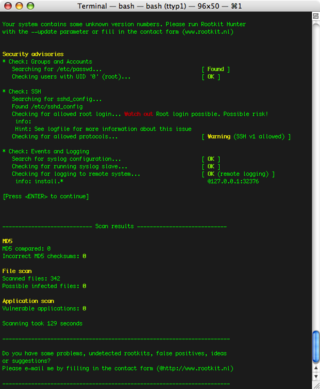
A packet analyzer, also known as packet sniffer, protocol analyzer, or network analyzer, is a computer program or computer hardware such as a packet capture appliance, that can intercept and log traffic that passes over a computer network or part of a network. Packet capture is the process of intercepting and logging traffic. As data streams flow across the network, the analyzer captures each packet and, if needed, decodes the packet's raw data, showing the values of various fields in the packet, and analyzes its content according to the appropriate RFC or other specifications.

An intrusion detection system is a device or software application that monitors a network or systems for malicious activity or policy violations. Any intrusion activity or violation is typically reported either to an administrator or collected centrally using a security information and event management (SIEM) system. A SIEM system combines outputs from multiple sources and uses alarm filtering techniques to distinguish malicious activity from false alarms.

A rootkit is a collection of computer software, typically malicious, designed to enable access to a computer or an area of its software that is not otherwise allowed and often masks its existence or the existence of other software. The term rootkit is a compound of "root" and the word "kit". The term "rootkit" has negative connotations through its association with malware.

An application firewall is a form of firewall that controls input/output or system calls of an application or service. It operates by monitoring and blocking communications based on a configured policy, generally with predefined rule sets to choose from. The application firewall can control communications up to the application layer of the OSI model, which is the highest operating layer, and where it gets its name. The two primary categories of application firewalls are network-based and host-based.

A host-based intrusion detection system (HIDS) is an intrusion detection system that is capable of monitoring and analyzing the internals of a computing system as well as the network packets on its network interfaces, similar to the way a network-based intrusion detection system (NIDS) operates. This was the first type of intrusion detection software to have been designed, with the original target system being the mainframe computer where outside interaction was infrequent.
Norton Internet Security, developed by Symantec Corporation, is a discontinued computer program that provides malware protection and removal during a subscription period. It uses signatures and heuristics to identify viruses. Other features include a personal firewall, email spam filtering, and phishing protection. With the release of the 2015 line in summer 2014, Symantec officially retired Norton Internet Security after 14 years as the chief Norton product. It was superseded by Norton Security, a rechristened adaptation of the Norton 360 security suite.

rkhunter is a Unix-based tool that scans for rootkits, backdoors and possible local exploits. It does this by comparing SHA-1 hashes of important files with known good ones in online databases, searching for default directories, wrong permissions, hidden files, suspicious strings in kernel modules, and special tests for Linux and FreeBSD. rkhunter is notable due to its inclusion in popular operating systems
In the field of computer network administration, pcap is an application programming interface (API) for capturing network traffic. While the name is an abbreviation of packet capture, that is not the API's proper name. Unix-like systems implement pcap in the libpcap library; for Windows, there is a port of libpcap named WinPcap that is no longer supported or developed, and a port named Npcap for Windows 7 and later that is still supported.

Security testing is a process intended to reveal flaws in the security mechanisms of an information system that protect data and maintain functionality as intended. Due to the logical limitations of security testing, passing the security testing process is not an indication that no flaws exist or that the system adequately satisfies the security requirements.

Argus – the Audit Record Generation and Utilization System is the first implementation of network flow monitoring, and is an ongoing open source network flow monitor project. Started by Carter Bullard in 1984 at Georgia Tech, and developed for cyber security at Carnegie Mellon University in the early 1990s, Argus has been an important contributor to Internet cyber security technology over its 30 years..
Database security concerns the use of a broad range of information security controls to protect databases against compromises of their confidentiality, integrity and availability. It involves various types or categories of controls, such as technical, procedural/administrative and physical.
Zeek is a free and open-source software network analysis framework. Vern Paxson began development work on Zeek in 1995 at Lawrence Berkeley National Lab. Zeek is a network security monitor (NSM) but can also be used as a network intrusion detection system (NIDS). The Zeek project releases the software under the BSD license.
Log management (LM) comprises an approach to dealing with large volumes of computer-generated log messages.
Prelude SIEM is a Security information and event management (SIEM).

OpenBSD is a security-focused, free and open-source, Unix-like operating system based on the Berkeley Software Distribution (BSD). Theo de Raadt created OpenBSD in 1995 by forking NetBSD 1.0. According to the website, the OpenBSD project emphasizes "portability, standardization, correctness, proactive security and integrated cryptography."
Cisco Security Monitoring, Analysis, and Response System (MARS) was a security monitoring tool for network devices. Together with the Cisco Security Manager (CSM) product, MARS made up the two primary components of the Cisco Security Management Suite.

Security information and event management (SIEM) is a field within the field of computer security, where software products and services combine security information management (SIM) and security event management (SEM). They provide real-time analysis of security alerts generated by applications and network hardware. Vendors sell SIEM as software, as appliances, or as managed services; these products are also used to log security data and generate reports for compliance purposes. The term and the initialism SIEM was coined by Mark Nicolett and Amrit Williams of Gartner in 2005.
Tiger is a security software for Unix-like computer operating systems. It can be used both as a security audit tool and a host-based intrusion detection system and supports multiple UNIX platforms. Tiger is free under the GPL license and unlike other tools, it needs only of POSIX tools, and is written entirely in shell language.
Sagan is an open source (GNU/GPLv2) multi-threaded, high performance, real-time log analysis & correlation engine developed by Quadrant Information Security that runs on Unix operating systems. It is written in C and uses a multi-threaded architecture to deliver high performance log & event analysis. Sagan's structure and rules work similarly to the Sourcefire Snort IDS/IPS engine. This allows Sagan to be compatible with Snort or Suricata rule management softwares and give Sagan the ability to correlate with Snort IDS/IPS data.
The following outline is provided as an overview of and topical guide to computer security:




